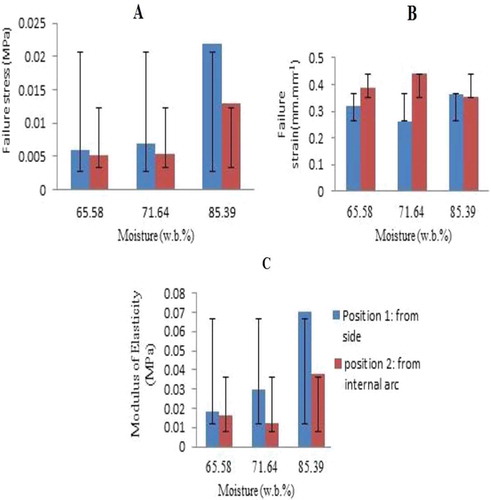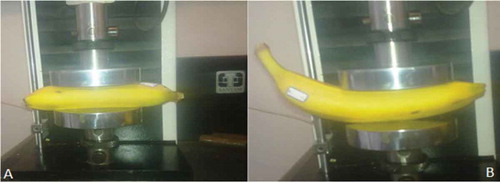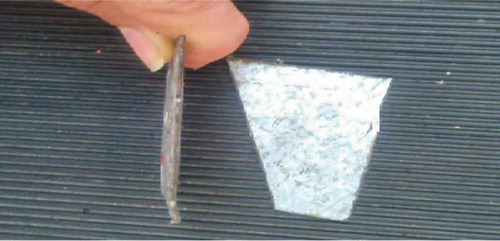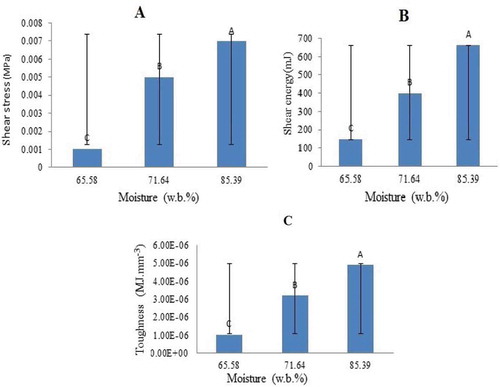ABSTRACT
During banana processing, knowledge of the mechanical properties of bananas is very important. To determine these mechanical properties, a shear-pressure loading test was used with three moisture content levels, three velocities for lowering the lever during the test, and two methods of placement in the pressure test with the force-deformation diagram and extracting from it. In the shear test, there was a significant relationship between the moisture content effect and the three mechanical properties. The maximum and minimum amounts of failure stress at the moisture content levels of 85.39% and 65.58% for the side and the internal arc of the banana placement methods occurred, respectively. Additionally, the maximum and minimum failure strain amounts at a moisture content of 71.64% for the second and first placement occurred, respectively. The maximum and minimum modulus of elasticity at the moisture content levels of 85.39 w.b.% and 71.64 w.b.% for the first and second placement occurred.
Nomenclature
| A | = | Area (mm2) |
| E | = | Elasticity modulus (MPa) |
| Gdm | = | Weight of dry matter (g) |
| Gw | = | Weight of the lost water (g) |
| Mw | = | Moisture content of sample (w.b.%) |
| P | = | Force (N) |
| r | = | The radius of cross section (mm) |
| V | = | Velocities (mm.min–1) |
Greek symbols
| = | Failure strain (mm.mm–1) | |
| Δr | = | Changes of the radius of cross section (mm) |
| = | Pressure stress (MPa) | |
| τ | = | Shear stress (MPa) |
Introduction
The banana is an herbaceous monocot; a shrub-like plant, it is the most popular tropical fruit and is usually picked before it is ripe. To determine the mechanical and physical properties of agricultural products, more attention has been paid to finding a benchmark for designing and building the machinery and equipment related to transmission, ranking, and processing of agricultural products. Poor results will be attained in the design of agricultural machines without considering these parameters (Rasekh et al., Citation2012). The goal of calculating the engineering properties of the banana (as with other agricultural products) under static and dynamic loadings is to reduce mechanical damage during transport and storage after harvest, processing, and storage and to calculate the design parameters for the harvesting phase and subsequent storage (Chukwu and Orhevba, Citation2011). Bananas have already drawn attention with respect to these topics in numerous studies. Kachro and colleagues (Citation1995) measured some mechanical and physical properties of two cultivars of green bananas (Dwarf Cavendish and Nendran) and found that the maximum force required for cutting a slice of banana was 22.4 and 28.2 N for Dwarf Cavendish and Nendran, respectively. The maximum energies for cutting a slice of Dwarf Cavendish and Nendran were 686.81 and 724.46 J.m−2, respectively.
Tapre and Jain (Citation2012) conducted an advanced study on the ripening stages of banana and found a significantly negative relationship between increased storage and these stages (reduction of humidity over time) and mechanical properties, including failure power. Similar studies have been done on the fruits having skin, some examples of which are as follows: The mechanical properties of three varieties of pistachio are related to moisture content and loading speed. There is a negative relationship between mechanical properties and reduced moisture content. Except for failure with point reshaping, a positive relationship exists between the mechanical properties of the pistachio and loading speed (Golmohammadi et al, Citation2013).
Bayat and Rezvani (Citation2012) studied the effect of harvest time and moisture content on the mechanical properties of garlic skin. According to the external skin, maximum cracking power was observed at moisture contents of 32% and 21%. Gholami et al. (Citation2012) attempted to determine the mechanical properties of the pistachio and its core (Ahmad Aghaee cultivar) and found that the failure force and failure energy for the pistachio and its core were decreased by increasing the moisture content from 4.6% to 35.6%.
Knowing the mechanical properties related to the behavior of agricultural products is vital for transport and storage. Determining these mechanical properties also allows one to take steps to reduce mechanical damage during transport and storage after harvesting, processing, and initial storage, and also to calculate effectual design parameters for harvesting systems and subsequent steps. Hence, the current research was conducted to determine some of the mechanical properties of bananas.
Material and methods
Preparation of samples
At first, a sufficient number of cultivar Cavendish bananas were purchased from the local market in Gorgan, Iran. Initial moisture content of the bananas was 90% using wet basis (w.b.%; (ASAE, Citation2001). Different moisture content levels of bananas were brought about by drying the bananas in the available dryer at low temperature, successive weighing, and calculating the weight difference to determine the desirable level of moisture content (Bart-Plange et al., Citation2012; Golmohammadi et al., Citation2013; Samimi Akhijahani and Khodaei, Citation2011). The final moisture content was obtained by Eq. (1) (Velayati et al., Citation2011):
Test method
For determining mechanical features, the shear-pressure loading test and transformation-force diagram were used. These tests were conducted using a pressure-stress device (model STM-5, Santam, Iran). The device had a dynamometer with a capacity of 50 kgf. The circular section of the device (diameter, 10 cm) was used to conduct the pressure test so that force was applied to the bananas from two different directions. shows the placement manner of the bananas and demonstrates the shear test from the metal blade with a thickness of 1 mm and a shear angle of 10°.
Failure stress was calculated by Eq. (2), where is failure stress in MPa; F is force of yield point in N; and A, the area under the sample load, is mm2. Shear stress was calculated using Eq. (3), where F is the force of shear point of the total sample and A is the area of cut section (Masoudi et al., Citation2005). The area was determined by ImageJ software (National Institutes of Health, Bethesda, MD, USA), a powerful software for image processing that can calculate areas and pixel value statistics in parts of a user’s picture. Failure strain was calculated by Eq. (4), where
is failure strain in mm.mm–1, Δr is the change of the radius at the yield point, and r0 is the sample radius. The apparent elasticity coefficient of the samples was in MPa and calculated by Eq. (5), given the length and cross section:
To calculate toughness (in MJ.mm–3), failure energy was divided by sample volume. Failure energy is the area under the force-displacement diagram to the failure point in MJ. Elastic force is given in terms of N, r0 is the initial radius in mm, the area of the sample is mm2, and Δr is the change of the sample radius in elastic limit in terms of mm. Preparation operation of data and determination of values were performed using Excel software (Microsoft Corporation, Redmond, Washington, USA); the SAS statistical application was used for the statistical analysis (SAS Software, SAS Institute Inc., Cary, NC, USA).
Results and discussion
Mechanical properties
Shear
According to the results of the variance analysis of the load speed and moisture content effects on shear stress, shear energy, and toughness of banana, the moisture content influenced three mechanical properties: shear energy, shear stress, and toughness. Loading speed and the mutual effect of moisture content and speed had no significant impact on the mechanical properties of shear stress, shear energy, and toughness.
and indicate the effect of moisture content on shear stress and shear energy, respectively. demonstrates the effect of moisture content on toughness. The minimum value of shear energy at 65.58% moisture content was attributable to softening skin that resulted from discharging moisture content (Singh and Reddy, Citation2006).
Pressure
The results of variance analysis related to the effect of moisture content, loading speed, and placement on the mechanical properties of pressure stress, pressure strain, pressure energy, toughness, and modulus of elasticity of bananas indicate that moisture content had a significant effect on pressure stress, pressure energy, toughness, and the modulus of elasticity. On the other hand, moisture content did not affect the pressure strain. Similar results were observed during research—namely, that placement had no significant effect on pressure energy and loading speed had no significant effect on the measured mechanical properties. The mutual effect of moisture content and placement on pressure energy was significant (Mirayi-Ashtiani et al., Citation2015). In another study, the mutual effects of moisture content and loading speed and also loading speed and placement were found to be insignificant for all of the measured mechanical features (Zhiguo and Colin, Citation2014). Other similar results (Mansouri and Minaei, Citation2006) have been produced in studies indicating that no significant relationship exists between loading speed and certain mechanical properties of the date (Zahedi cultivar), including force and energy.
indicates the results of average comparison of mutual effect of moisture content and placement on failure stress, failure strain, and elasticity module. According to the table, the maximum value of failure stress at a moisture content of 85.39% with the first placement method (from the side) was 0.002 MPa; the minimum value of failure stress at a moisture content of 65.58% with the second method of placement (from the internal arc of banana) was 0.00051 MPa. As a result, at lower moisture content with placement from the internal arc of the fruit, the banana fruit failed under less stress. The loss of water in the fruit due to low moisture content causes its tissues to be separable with less force.
Table 1. Comparative results of average of mutual effect of moisture and loading direction on failure stress, failure strain, and elasticity module.
shows the effect of moisture content and placement on failure stress. According to the figure, there was a positive relationship between moisture content reduction and reduced failure stress, as discharge of moisture rendered the banana skin more fragile. Also, at any moisture content failure stress was lower for the second placement (from internal arc of banana). In the first placement (from side), force perpendicular to the fruit thickness was applied; in the second placement (from internal arc of banana), force was applied perpendicular to the fruit. Since the fruit width is greater than its thickness, the second placement (from the internal arc of the banana) leads to less mechanical stress.
Figure 4. Mutual effect of moisture and placement on (A) failure stress, (B) failure strain, and (C) elasticity module of banana fruit.

According to , the maximum value of failure strain at a moisture content of 71.64% with the second placement (from internal arc of banana) was 0.44 mm.mm–1 and the minimum value of failure strain for moisture content of 71.64% and the first placement was calculated as 0.26 mm.mm–1.
indicates the effects of moisture content and placement on failure strain. It can be concluded from the variety that, at first, failure strain was reduced in the first placement (from the side) and then increased, while the opposite was true for the second placement (from the internal arc of banana). In addition to placement, this difference was related to moisture content: reduction of the moisture content at first softened the fruit, creating a greater change of length at the point of failure; but, with continuing reduction in moisture content, the fruit became fragile with reduced changes in length.
According to , the maximum value of the modulus of elasticity at a moisture content of 85.39% with the first placement (from the side) was 0.07 MPa, and the minimum value of the modulus of elasticity at a moisture content of 71.64% with the second placement was 0.012 MPa.
depicts the effects of moisture content and placement on the modulus of elasticity, which strongly increased with the second moisture content. At any moisture content, the modulus of elasticity with the first placement (from the side) was higher than that of the second placement (from the internal arc of the banana). This sudden change was due to the discharge of intracellular water to an inter-cell area, since moisture content within the fruit turned to water first and then evaporated.
Conclusion
In this research, some mechanical properties of the banana fruit (Cavendish cultivar) were studied at three levels of moisture content (85.39, 71.64, and 65.58 w.b.%), three velocities (5, 50, and 100 mm.min–1) for lowering the device’s lever in shear and pressure tests, and two manners of placement (from the side, from the internal arc of the banana) under pressure. The results indicated that:
Reduced moisture content had a significant impact on mechanical properties during the cutting of bananas.
The best moisture content for cutting banana was 65.58%, since both shear energy and shear stress for the banana were less than for other moisture content levels.
High failure energy is appropriate for transporting at a moisture content of 85.39%.
The maximum reduction of failure stress level occurred at a moisture content of 65.58% with the second manner of placement (from internal arc of banana).
In other words, bananas experience maximal damage during transportation and storage at the 65.58% moisture level.
Conferring minimum strain were a moisture content of 71.64% and the first manner of placement (from the side).
The minimum and maximum modulus of elasticity were calculated at a moisture content of 71.64%, while the best placement of the banana in the storage facility was the first manner of placement (from side) and the best moisture content level was 71.64%.
Literature cited
- ASAE. 2001. Moisture measurement-unground grain and seeds. ASAE Standard S352.2.
- Bart-Plange, A., A. Addo, H. Ofori, and V. Asare. 2012. Thermal properties of Gros Michel banana grown in Ghana. Asian Res. Publish. Network 7(4):478–484.
- Bayat, F., and S. Rezvani. 2012. Effect of harvesting time and moisture on mechanical properties of garlic (Allium sativum L.) skin. CIGR J. 14(3):161–167.
- Chukwu, O., and B. Orhevba. 2011. Determination of selected engineering properties of soybean (glycine max) related to design of processing machine. J. Agr. Food Technol. 1(6):68–72.
- Gholami, M., B. Gooshki, A.M. Kermani, and M. Rashidi. 2012. Determination of some physical properties of pistachio nut and its kernel (Ahmad Aghaei Variety). Innov. Food Sci. Technol. 4(3):91–100.
- Golmohammadi, A., P. Sabouri, and T. Gundoshmian. 2013. The effect of moisture content on some mechanical properties of three varieties of pistachio nuts. J. Food Eng. 37:212–221.
- Kachro, R.P., N. Kotwaliwale, and D. Balasubramanian. 1995. Physical and mechanical properties of green banana (Musa paradisiaca) fruit. J. Food Eng. 26(3):369–378.
- Mansouri Y., and S. Minaei. 2006. Effect of fruit load on the mechanical properties of two-digit date Khuzestan province (Varietys Sayer and Zahedi). J. Agr. Sci. 28(2):11–23.
- Masoudi, H., A. Tabatabaeefar, A.M. Borghei, and M.A. Shahbeik. 2005. Determination and comparison of physical and mechanical properties of three export varieties of apple. J. Agr. Sci. 11(3):216–231.
- Mirayi-Ashtiani, S.H., M.R. Golzarian, J. Baradaran-Motie, B. Emadi, N. Nikoo-Jamal, and H. Mohammadinezhad. 2015. Effect of loading position and storage duration on the textural properties of eggplant. Intl. J. Food Prop. 18(1):1–31.
- Rasekh, M., A.H. Afkari-Sayyah, and A. Bodaghi. 2012. Determination of some physical and mechanical properties of two varieties of almond kernel, under cutting loading. J. Sci. Food Technol. 32(2):69–78.
- Samimi Akhijahani, H., and J. Khodaei. 2011. Some physical properties of strawberry (Kurdistan variety). World Appl. Sci. J. 13(2):206–212.
- Singh, K., and S. Reddy. 2006. Post-harvest physico-mechanical properties of orange peel and fruit. J. Food Eng. 73(2):112–120.
- Tapre, A.R., and R.K. Jain. 2012. Study of advanced maturity stages of banana. Intl. J. Adv. Eng. Res. Stud. 1(3):272–274.
- Velayati, E., B. Emadi, M. Khojastehpour, and M.H. Saiedirad. 2011. Effect of moisture content on mechanical properties and terminal velocity of Berberis. J. Agrl. Machin. 1(2):100–109 ( text in Persian).
- Zhiguo, L., and T. Colin. 2014. Effect of number of locules, loading position, and compression speed on the mechanical behaviors of tomato fruits. Intl. J. Food Prop. 18(6):1350–1358.



